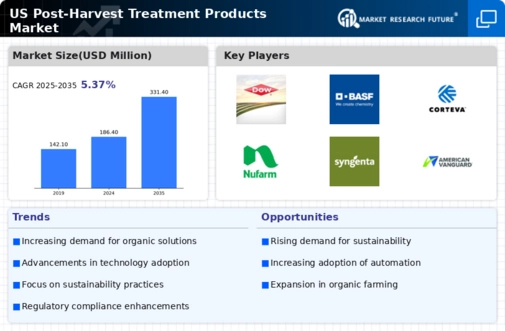The US Post-Harvest Treatment Products Market is characterized by a diverse array of products designed to enhance the quality and longevity of agricultural produce after harvest. This market is vital for ensuring that fruits, vegetables, and other commodities maintain their freshness and appeal, ultimately impacting consumer satisfaction and market viability. The competitive landscape is shaped by various players focused on innovative approaches to post-harvest care, including treatments for pest control, disease management, and preservation technologies.
Companies are increasingly engaging in research and development activities to formulate new products that meet the evolving demands of growers and distributors, while also adhering to regulatory standards. The emphasis on sustainability in agriculture is also influencing product development, leading to an increased focus on environmentally friendly solutions that do not compromise on effectiveness. FMC Corporation stands out in the US Post-Harvest Treatment Products Market due to its comprehensive portfolio of crop protection products, including those specifically formulated for post-harvest applications.
The company's strengths lie in its innovative research capabilities and a strong focus on sustainability, enabling it to develop solutions that cater to the unique needs of growers in the region. FMC Corporation has established a significant presence in the market through its commitment to customer service and support, providing educational resources and technical assistance to ensure optimal use of its products.
Moreover, the company’s strategic partnerships and collaborations with agricultural stakeholders enhance its ability to respond to market demands effectively, thereby strengthening its competitive position within the industry.Sealed Air Corporation is another key player in the US Post-Harvest Treatment Products Market, recognized for its role in providing packaging solutions and specialty products aimed at preserving the freshness of agricultural produce. The company offers a variety of key products and services, including film technologies and cushioning solutions that minimize damage during transport and storage.
Sealed Air Corporation has built a robust market presence by focusing on innovation and excellence in customer service, ensuring that its offerings not only meet but exceed industry expectations. The company's strengths are further bolstered by strategic mergers and acquisitions that expand its product range and market reach, fostering a deeper integration into the supply chains of key agricultural sectors. By leveraging its expertise in packaging and post-harvest treatment, Sealed Air Corporation continues to contribute significantly to the operational efficiency and profitability of its clients within the US market.

















